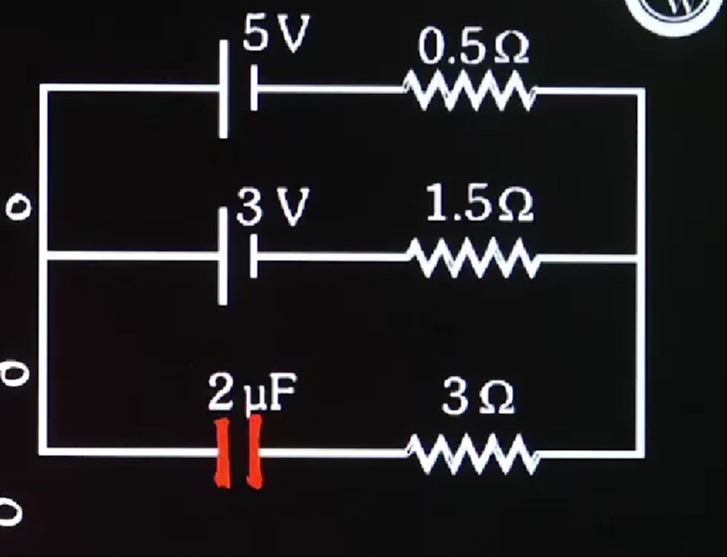Question
Question: 5 V 0.5$\Omega$ 3 V 1.5$\Omega$ 2 $\mu$F 3$\Omega$...
5 V 0.5Ω 3 V 1.5Ω 2 μF 3Ω

The charge on the capacitor is 9 μC.
The charge on the capacitor is -9 μC.
The voltage across the capacitor is 4.5 V.
The voltage across the capacitor is -4.5 V.
The charge on the capacitor is 9 μC.
Solution
In a steady-state DC circuit, a capacitor acts as an open circuit, meaning no current flows through its branch. Let VA and VB be the potentials of the common nodes.
For the first branch: VA−VB=−5 V+0.5I1, where I1 is the current from A to B. For the second branch: VA−VB=−3 V+1.5I2, where I2 is the current from A to B. For the third branch (capacitor): In steady state, the current I3=0. The voltage across the capacitor is VC=VA−VB.
By KCL at node A: I1+I2+I3=0. Since I3=0, I1+I2=0, which means I2=−I1.
Substituting I2=−I1 into the second branch equation: VA−VB=−3 V+1.5(−I1)=−3 V−1.5I1.
Equating the expressions for VA−VB: −5+0.5I1=−3−1.5I1 2I1=2 I1=1 A.
Now, calculate VA−VB: VA−VB=−5+0.5(1)=−4.5 V.
The voltage across the capacitor is VC=VA−VB=−4.5 V. The charge on the capacitor is Q=CVC. C=2μF =2×10−6 F. Q=(2×10−6 F)×(−4.5 V)=−9×10−6 C =−9μC.
The negative sign indicates the polarity of the charge. The magnitude of the charge on the capacitor is 9μC.
